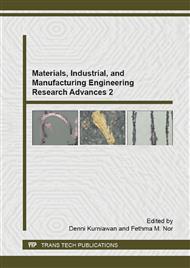[1]
Chun-Zhao Liu, Feng Wang, Amanda R. Stiles, Chen Guo, (2012). Ionic liquids for biofuel production, In: Opportunities and challenges Applied Energy vol. 92, p.406–414.
DOI: 10.1016/j.apenergy.2011.11.031
Google Scholar
[2]
Nibedita Sarkar, Sumanta Kumar Ghosh, Satarupa Bannerjee, Kaustav Aikat, (2012). Bioethanol production from agricultural wastes, In: An overview. Renewable Energy vol. 37, pp.19-27.
DOI: 10.1016/j.renene.2011.06.045
Google Scholar
[3]
Gabriela Ghizzi D. Silva, M. C. -G, (2012). Effects of grinding processes on enzymatic degradation of wheat straw, Technology vol. 103, pp.192-200.
Google Scholar
[4]
Tony Vancov, Amy-Sue Alston, Trevor Brownb, Shane McIntosh, (2012). Use of ionic liquids in converting lignocellulosic material to biofuels, In : Renewable Energy vol. 45, pp.1-6.
DOI: 10.1016/j.renene.2012.02.033
Google Scholar
[5]
Mosier N., Wyman C., Dale B., Elander R., Lee Y.Y., Holtzapple M., Ladisch M., (2005). Features of promising technologies for pretreatment of lignocellulosic biomass, In: Bioresource Technology vol. 96, pp.673-686.
DOI: 10.1016/j.biortech.2004.06.025
Google Scholar
[6]
Maria Teresa García-Cubero, M. C. -B., (2010). Chemical Oxidation with Ozone as Pre-treatment of Lignocellulosic Materials for Bioethanol Production, In: Chemical Engineering Transactions, pp.1273-1278.
Google Scholar
[7]
Kratky L., Jirout T., (2011). Biomass Size Reduction Machines for Enhancing Biogas Production, In: Chemical Engineering & Technology vol. 34(3), pp.391-399.
DOI: 10.1002/ceat.201000357
Google Scholar
[8]
Qingqi Yan, M. M., (2012). Mechanical Pretreatment of Lignocellulosic Biomass Using a Screw Press as an Essential Step in the Biofuel Production, In: Chemical engineering transaction vol. 29, pp.601-606.
Google Scholar
[9]
Cardona CA, Quintero JA, Paz IC, (2010). Production of bioethanol from sugarcane bagasse status and perspectives, In : Bioresource Technology vol. 101(13), pp.4754-4766.
DOI: 10.1016/j.biortech.2009.10.097
Google Scholar
[10]
Verónica García, V. G., (2011). Challenges in biobutanol production: How to improve the efficiency?, In : Renewable and Sustainable Energy Reviews, vol. 15, p.964–980.
DOI: 10.1016/j.rser.2010.11.008
Google Scholar
[11]
Taherzadeh M.J., Karimi K., (2007). Acid-based hydrolysis processes for ethanol from lignocellulosic materials: a review, In: BioResources vol. 2, p.472–99.
Google Scholar
[12]
Pandey A, Soccol CR, Nigam P, Soccol V.T., (2000). Biotechnological potential of agro-industrial residues sugarcane baggase, In: Bioresource Technology vol 74, pp.69-80.
DOI: 10.1016/s0960-8524(99)00142-x
Google Scholar
[13]
M. Saritha, A. A., (2012). Biological Pretreatment of Lignocellulosic Substrates for Enhanced Delignification and Enzymatic Digestibility, In: Indian J Microbiol, vol. 52(2), p.122–130.
DOI: 10.1007/s12088-011-0199-x
Google Scholar
[14]
Rodolfo Travaini, M. D. -S., (2012). Sugarcane bagasse ozonolysis pretreatment: Effect on enzymatic digestibility and inhibitory compound formation, In: Bioresource Technology vol. 133, p.332–339.
DOI: 10.1016/j.biortech.2013.01.133
Google Scholar
[15]
Yu, Z., Jameel, H., Chang, H. -M., Park S., (2011). The effect of delignification of forest biomass on enzymatic hydrolysis, In: Biosource Technology vol. 102, p.9083–9089.
DOI: 10.1016/j.biortech.2011.07.001
Google Scholar
[16]
Bian J., Peng F., X.P. Peng, Peng X. Xiao, Peng P., Xu F., R.C. Sun., (2013). Effect of [Emim]Ac pretreatment on the structure and enzymatic hydrolysis of sugarcane bagasse cellulose. Carbohydrate Polymers, 100: 211-217.
DOI: 10.1016/j.carbpol.2013.02.059
Google Scholar
[17]
Lopes A.M. da Costa, Joao K.G., Rubik D.F., Bogel-Lukasik E., Duarte L.C., Andreaus J., Bogel-Lukasik R., (2013). Pre-treatment of lignocellulosic biomass using ionic liquids: Wheat straw fractionation. Bioresource Technology, 142: 198–208.
DOI: 10.1016/j.biortech.2013.05.032
Google Scholar
[18]
Zhao D., Li H., Zhang J., Fu L., Liu M., Fu J., Ren P., (2012). Dissolution of cellulose in phosphate-based ionic liquids. Carbohydrate Polymers, 87: 1490-1494.
DOI: 10.1016/j.carbpol.2011.09.045
Google Scholar
[19]
Haykir N.I., Bahcegul E., Bicak N., Bakir U., (2013). Pretreatment of cotton stalk with ionic liquids including 2-hydroxy ethyl ammonium formate to enhance biomass digestibility. Industrial Crops and Products, 41: 430-436.
DOI: 10.1016/j.indcrop.2012.04.041
Google Scholar
[20]
Farid Talebnia, D.K., (2010). Production of bioethanol from wheat straw: An overview on pretreatment, hydrolysis and fermentation, In: Bioresource Technology vol. 101, p.4744–4753.
DOI: 10.1016/j.biortech.2009.11.080
Google Scholar
[21]
Balat M., (2011). Production of bioethanol from lignocellulosic materials via the biochemical, In: Energy Conversion and Management vol. 52 , p.858–875.
DOI: 10.1016/j.enconman.2010.08.013
Google Scholar
[22]
Sun Y., Cheng J.Y., (2002). Hydrolysis of lignocellulosic materials for ethanol production: a review, In: Bioresource Technology vol 83, p.10–11.
DOI: 10.1016/s0960-8524(01)00212-7
Google Scholar
[23]
Teramoto Y., Lee S., Endo T., (2008). Pretreatment of woody andherbaceous biomass for enzymatic saccharification using sulfuric acid-free ethanol cooking, In: Bioresource Technology vol. 99, p.8856.
DOI: 10.1016/j.biortech.2008.04.049
Google Scholar
[24]
Azmi I.S., Azizan A., Ruzitah M.S., Jalil R., Sihab A.L., Ubong S., Idris N. (ii) Green Engineering Technologies in Bioethanol Production, In: IEEE Symposium on Humanities, Science and Engineering SHUSER (2013).
DOI: 10.4028/www.scientific.net/amr.701.243
Google Scholar
[25]
C. Kamarludin S.N., Jainal M.S., Azizan A., Mohd Safaai N.S., Mohamad Daud A.R. 'Mechanical Pretreatment of Lignocellulosic Biomass Prior to Biofuel Production, In: The 3rd International Conference on Process Engineering and Advanced Material (ICPEAM 2014), 3-5 June 2014, Kuala Lumpur Convention Centre, Kuala Lumpur, Malaysia [ACCEPTED].
DOI: 10.4028/www.scientific.net/amm.625.838
Google Scholar
[26]
Barakat A., Chuetor S., Monlau F., Solhy A., Rouau X., (2014). Eco-friendly dry chemo-mechanical pretreatments of lignocellulosic biomass: Impact on energy and yield of the enzymatic hydrolysis, In: Applied Energy vol. 113, p.97–105.
DOI: 10.1016/j.apenergy.2013.07.015
Google Scholar


